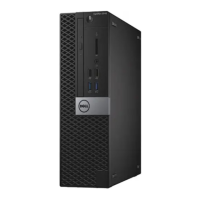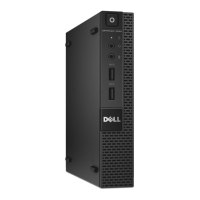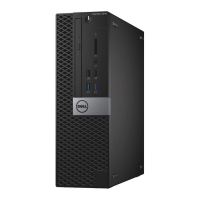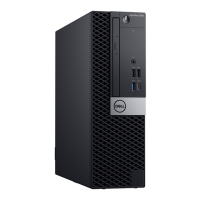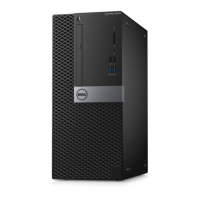Do you have a question about the Dell OptiPlex 5050 and is the answer not in the manual?
Essential safety guidelines to protect users and the computer.
Steps to prepare the computer before performing internal procedures.
Procedures for properly shutting down the computer.
Steps to complete after performing internal computer tasks.
List of tools required for component removal and installation.
Instructions for removing and installing the computer's back cover.
Procedures for removing and installing expansion cards.
Steps to remove and install the coin cell battery.
Instructions for removing and installing the front bezel.
Procedures for removing and installing the internal speaker.
Steps to remove and install the chassis intrusion switch.
Information on removing and installing storage drives (HDD/SSD).
Procedures for removing and installing the optical drive.
Steps to remove and install the M.2 PCIe SSD.
Instructions for removing and installing the heat sink assembly.
Procedures for removing and installing the computer processor.
Steps to remove and install memory modules.
Instructions for removing and installing the SD card reader.
Procedures for removing and installing the power supply unit (PSU).
Steps to remove and install the computer power switch.
Procedures for removing and installing the system board.
Diagram and labels identifying system board components.
Introduction to the M.2 Intel Optane Memory Module.
Requirements for the Intel Optane Memory Module driver.
Procedures for removing and installing the M.2 Intel Optane module.
Overview of Universal Serial Bus (USB) features and evolution.
Details on SuperSpeed USB technology and its benefits.
Explanation of HDMI 1.4 standard and its features.
How to configure the computer's boot device order.
Explanation of keys used in System Setup navigation.
How to set and manage system and setup passwords.
Overview of available System Setup configuration options.
Instructions for updating the BIOS from within Windows.
Steps to enable the Smart Power On feature.
List of operating systems supported by the computer.
Guide on how to download device drivers from Dell.
Information on installing Intel chipset drivers.
Instructions for installing Intel HD Graphics drivers.
Explanation of power LED status codes for troubleshooting.
List and explanations of diagnostic error messages.
List and explanations of system error messages.
Details on the processor types and configurations.
Information on memory type, speed, and capacity.
Details on integrated and discrete video controllers.
Information on the audio controller.
Details on network adapters and wireless capabilities.
Information on supported hard drives and SSDs.
Listing of all available ports and connectors.
Details on the power supply unit type and rating.
Operating conditions like temperature, humidity, and shock.
Essential safety guidelines to protect users and the computer.
Steps to prepare the computer before performing internal procedures.
Procedures for properly shutting down the computer.
Steps to complete after performing internal computer tasks.
List of tools required for component removal and installation.
Instructions for removing and installing the computer's back cover.
Procedures for removing and installing expansion cards.
Steps to remove and install the coin cell battery.
Instructions for removing and installing the front bezel.
Procedures for removing and installing the internal speaker.
Steps to remove and install the chassis intrusion switch.
Information on removing and installing storage drives (HDD/SSD).
Procedures for removing and installing the optical drive.
Steps to remove and install the M.2 PCIe SSD.
Instructions for removing and installing the heat sink assembly.
Procedures for removing and installing the computer processor.
Steps to remove and install memory modules.
Instructions for removing and installing the SD card reader.
Procedures for removing and installing the power supply unit (PSU).
Steps to remove and install the computer power switch.
Procedures for removing and installing the system board.
Diagram and labels identifying system board components.
Introduction to the M.2 Intel Optane Memory Module.
Requirements for the Intel Optane Memory Module driver.
Procedures for removing and installing the M.2 Intel Optane module.
Overview of Universal Serial Bus (USB) features and evolution.
Details on SuperSpeed USB technology and its benefits.
Explanation of HDMI 1.4 standard and its features.
How to configure the computer's boot device order.
Explanation of keys used in System Setup navigation.
How to set and manage system and setup passwords.
Overview of available System Setup configuration options.
Instructions for updating the BIOS from within Windows.
Steps to enable the Smart Power On feature.
List of operating systems supported by the computer.
Guide on how to download device drivers from Dell.
Information on installing Intel chipset drivers.
Instructions for installing Intel HD Graphics drivers.
Explanation of power LED status codes for troubleshooting.
List and explanations of diagnostic error messages.
List and explanations of system error messages.
Details on the processor types and configurations.
Information on memory type, speed, and capacity.
Details on integrated and discrete video controllers.
Information on the audio controller.
Details on network adapters and wireless capabilities.
Information on supported hard drives and SSDs.
Listing of all available ports and connectors.
Details on the power supply unit type and rating.
Operating conditions like temperature, humidity, and shock.
| Bus type | DMI3 |
|---|---|
| Stepping | S0 |
| Tjunction | 100 °C |
| Processor cache | 3 MB |
| Processor cores | 2 |
| Processor model | i3-7100 |
| System bus rate | 8 GT/s |
| Processor family | Intel® Core™ i3 |
| Processor socket | LGA 1151 (Socket H4) |
| Processor threads | 4 |
| Processor codename | Kaby Lake |
| Processor frequency | 3.9 GHz |
| Processor cache type | Smart Cache |
| Processor lithography | 14 nm |
| Processor manufacturer | Intel |
| PCI Express slots version | 3.0 |
| Processor operating modes | 64-bit |
| ECC supported by processor | No |
| PCI Express configurations | 1x16, 1x8+2x4, 2x8 |
| Thermal Design Power (TDP) | 51 W |
| Number of processors installed | 1 |
| Maximum number of PCI Express lanes | 16 |
| Memory types supported by processor | DDR3L-SDRAM, DDR4-SDRAM |
| Memory clock speeds supported by processor | 1333, 1600, 2133, 2400 MHz |
| Maximum internal memory supported by processor | 64 GB |
| On-board graphics card | Yes |
| On-board graphics card ID | 0x5912 |
| Discrete graphics card model | Not available |
| On-board graphics card model | Intel® HD Graphics 630 |
| On-board graphics card OpenGL version | 4.4 |
| On-board graphics card base frequency | 350 MHz |
| On-board graphics card DirectX version | 12.0 |
| On-board graphics card dynamic frequency (max) | 1100 MHz |
| Number of displays supported (on-board graphics) | 3 |
| Memory slots | 4x DIMM |
| Internal memory | 4 GB |
| Memory channels | Dual-channel |
| Memory clock speed | 2400 MHz |
| Internal memory type | DDR4-SDRAM |
| Memory layout (slots x size) | 1 x 4 GB |
| HDD size | 3.5 \ |
| HDD speed | 7200 RPM |
| HDD interface | SATA |
| Storage media | HDD |
| Optical drive type | DVD±RW |
| Total storage capacity | 500 GB |
| Cabling technology | 10/100/1000Base-T(X) |
| Ethernet LAN data rates | 10, 100, 1000 Mbit/s |
| HDMI version | 1.4 |
| USB 2.0 ports quantity | USB 2.0 ports have a data transmission speed of 480 Mbps, and are backwards compatible with USB 1.1 ports. You can connect all kinds of peripheral devices to them. |
| VGA (D-Sub) ports quantity | - |
| USB 3.2 Gen 1 (3.1 Gen 1) Type-A ports quantity | 6 |
| USB 3.2 Gen 1 (3.1 Gen 1) Type-C ports quantity | 0 |
| Chassis type | Mini Tower |
| Product color | Black |
| Placement supported | Horizontal/Vertical |
| Audio chip | Realtek ALC3234 |
| Product type | PC |
| Motherboard chipset | Intel® Q270 |
| Power supply | 240 W |
| Power supply input voltage | 90 - 264 V |
| Power supply input frequency | 47 - 63 Hz |
| Operating altitude | -15.2 - 3048 m |
| Non-operating altitude | -15.2 - 10668 m |
| Storage temperature (T-T) | -40 - 65 °C |
| Operating temperature (T-T) | 0 - 35 °C |
| Storage relative humidity (H-H) | 5 - 95 % |
| Operating relative humidity (H-H) | 10 - 90 % |
| Cables included | AC |
| Scalability | 1S |
| Processor code | SR35C |
| Processor ARK ID | 97455 |
| Processor package size | 37.5 x 37.5 mm |
| Supported instruction sets | AVX 2.0, SSE4.1, SSE4.2 |
| Thermal solution specification | PCG 2015C |
| Intel Identity Protection Technology version | 1.00 |
| Intel Stable Image Platform Program (SIPP) version | 0.00 |
| Depth | 274.32 mm |
|---|---|
| Width | 154 mm |
| Height | 350.52 mm |
| Weight | 7930 g |
